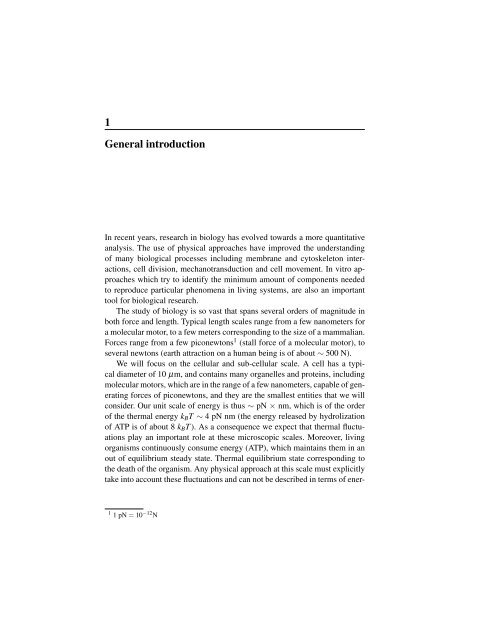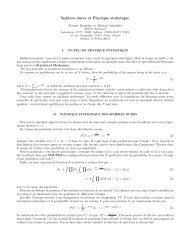Thesis (pdf) - Espci
Thesis (pdf) - Espci
Thesis (pdf) - Espci
Create successful ePaper yourself
Turn your PDF publications into a flip-book with our unique Google optimized e-Paper software.
1<br />
General introduction<br />
In recent years, research in biology has evolved towards a more quantitative<br />
analysis. The use of physical approaches have improved the understanding<br />
of many biological processes including membrane and cytoskeleton interactions,<br />
cell division, mechanotransduction and cell movement. In vitro approaches<br />
which try to identify the minimum amount of components needed<br />
to reproduce particular phenomena in living systems, are also an important<br />
tool for biological research.<br />
The study of biology is so vast that spans several orders of magnitude in<br />
both force and length. Typical length scales range from a few nanometers for<br />
a molecular motor, to a few meters corresponding to the size of a mammalian.<br />
Forces range from a few piconewtons 1 (stall force of a molecular motor), to<br />
several newtons (earth attraction on a human being is of about ∼ 500 N).<br />
We will focus on the cellular and sub-cellular scale. A cell has a typical<br />
diameter of 10 µm, and contains many organelles and proteins, including<br />
molecular motors, which are in the range of a few nanometers, capable of generating<br />
forces of piconewtons, and they are the smallest entities that we will<br />
consider. Our unit scale of energy is thus ∼ pN × nm, which is of the order<br />
of the thermal energy kBT ∼ 4 pN nm (the energy released by hydrolization<br />
of ATP is of about 8 kBT ). As a consequence we expect that thermal fluctuations<br />
play an important role at these microscopic scales. Moreover, living<br />
organisms continuously consume energy (ATP), which maintains them in an<br />
out of equilibrium steady state. Thermal equilibrium state corresponding to<br />
the death of the organism. Any physical approach at this scale must explicitly<br />
take into account these fluctuations and can not be described in terms of ener-<br />
1 1 pN = 10 −12 N




